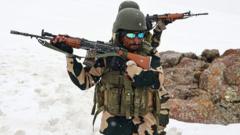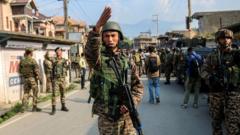The military conflict between India and Pakistan has escalated again, prompting both nations to realign their arms procurement strategies. India is moving away from traditional allies like Russia in favor of Western suppliers, while Pakistan has increasingly relied on China for military needs.**
Redefining Power Dynamics: India's Shift in Arms Procurement Amidst Tensions with Pakistan**

Redefining Power Dynamics: India's Shift in Arms Procurement Amidst Tensions with Pakistan**
The ongoing military strife between India and Pakistan unveils significant shifts in defense procurement strategies, with India aligning more with Western suppliers while Pakistan turns to China.**
The recent escalation in military confrontations between India and Pakistan has led to a noticeable shift in defense dynamics. Following the deadly terrorist attack on tourists in Indian-controlled Kashmir, both nations are at odds once again, echoing sentiments from their previous military engagement in 2019, which had alarmed U.S. officials amid concerns over nuclear readiness.
Historically, India maintained a cordial relationship with Russia, relying heavily on them for arms supplies. However, in an evolving geopolitical landscape, India has taken substantial steps toward strengthening its alignment with Western nations, significantly reducing its dependence on Russian arms. Current statistics indicate that India is now procuring a majority of its military equipment from Western allies, notably France and the United States, fostering a strategic partnership aimed at counterbalancing regional threats.
Conversely, Pakistan, witnessing a diminishing relevance to U.S. interests post-Afghanistan, has witnessed its military alliances take a different trajectory. The country is pivoting almost entirely towards China for its arms supplies, marking a significant drop in military acquisitions from Western countries. The preference for Chinese arms has become clear, as Pakistan favors the cost-effectiveness and availability of these supplies over Western options.
The armed tensions in South Asia, compounded by renewed conflict, highlights the reshaping of long-entrenched partnerships and underscores the ongoing shift in global arms trade patterns driven by strategic, political, and military realities. As these two nuclear-armed states navigate their complex relationships and military engagements, the world watches closely, aware that the implications of their actions extend far beyond regional boundaries.




















